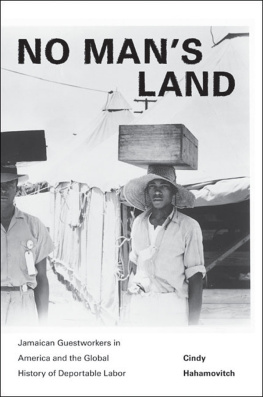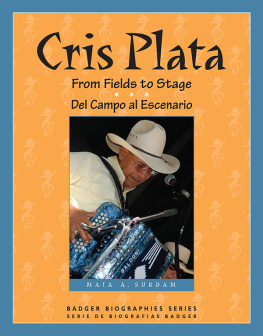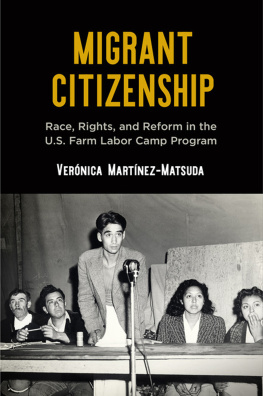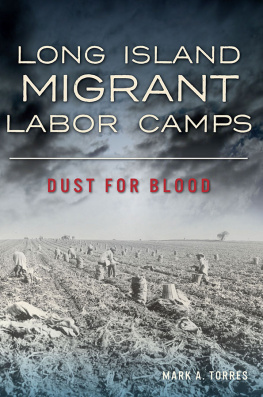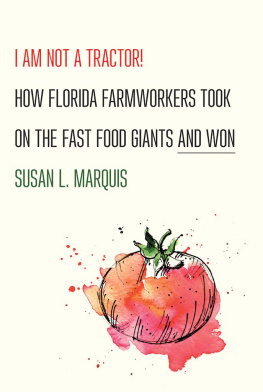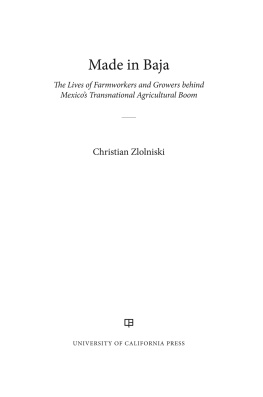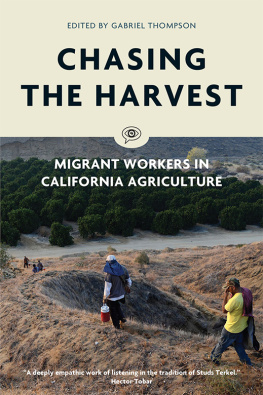1997 The University of North Carolina Press
All rights reserved
Manufactured in the United States of America
The paper in this book meets the guidelines for permanence and durability of the Committee on Production Guidelines for Book Longevity of the Council on Library Resources.
Library of Congress Cataloging-in-Publication Data
Hahamovitch, Cindy.
The fruits of their labor: Atlantic coast farmworkers and
the making of migrant poverty, 1870-1945/by
Cindy Hahamovitch.
p. cm.
Includes bibliographical references and index.
ISBN 0-8078-2330-9 (cloth: alk. paper).
ISBN 0-8078-4639-2 (pbk.: alk. paper)
1. Migrant agricultural laborersAtlantic States
History. I. Title. II. Title: Atlantic coast farmworkers and the making of migrant poverty.
HD1527.A9H34 1997
331.5'44'0975-dc20
96-41762
CIP
01 00 99 98 97 5 4 3 2 1
THIS BOOK WAS DIGITALLY PRINTED.
Acknowledgments
In 1988, when I was in graduate school at the University of North Carolina at Chapel Hill and I was supposed to be doing something scholarly like writing a dissertation, I was actually spending a good deal of time agitating for better pay for various folks, including myself. On one particular occasion, while I was going door to door in the history department, poindessly collecting faculty signatures on a petition calling for raises for graduate students, I happened to meet the southern historian George Tindall for the first time. He asked me what my work was about, and I answered, rather sheepishly, that I was fishing around for a topic and would probably write on nineteenth-century convict labor. He responded not by complimenting me on my choice of subject but by asking, quite out of the blue, if I knew when the farm labor migrant stream had started on the East Coast of the United States. He assumed that it had begun during the Great Depression but had been asking this question of similarly aimless graduate students for fifteen years without getting an answer. I had actually done some research on Floridas citrus industry as an undergraduate at Rollins College, but I did not know the answer to his question either. All the workers I met while in Florida were Mexicans, and I did know that Mexicans had only arrived on the scene a few years earlier.
My adviser, Leon Finkalways willing to brave new watersapproved the subject switch, and five years later I had Tindalls answer, although my response was probably about 500 pages longer than what he had had in mind. When I began looking into the subject, farmworkers had been migrating for over 100 years in the East (although in a number of streams, not one coherent movement). In the 1880s most of them were African Americans from the South and Italian Americans from Philadelphia, although there were smatterings of other peoples, such as Poles around Baltimore and Bahamians around the edges of South Florida. They were drawn to various points along the coast by the rise of the truck farming industry in the decades following the Civil War. Tindall was right about the importance of the 1930s, however, for the Great Depression greatly increased the numbers of people searching for agricultural work and created what contemporaries called the permanent transient, the migrant farmworker whose home was a Belle Glade flophouse, a growers tent, or the back seat of a jalopy. How many migrant farmworkers there were at any particular moment was impossible to ascertain. They presented moving targets to census takers who were rarely known to knock on car doors. Trying to find out how many were women was even more frustrating as various observers would note the presence of women and leave it at that. Migrant labor history and quantitative methods go together like fruit and frost.
There was still a lot I did not know, and what I did learn for certain was not at all what I expected. Knowing that farmworkers had been excluded from New Deal collective bargaining legislation, the Social Security Act, and the Fair Labor Standards Act, I had presumed that twentieth-century farm labor relations would be a sort of throwback to the nineteenth century, when industrial workers were similarly unprotected and usually unorganized, and when employers were less restrained in their use of violence. Studying farmworkers, then, would allow me to see what happened to workers who were completely abandoned by the state.
I was right about some of it. I certainly found evidence of unrestrained violence on the part of growers, and I rarely found agricultural labor unions that lasted more than a few weeks or a few months. But 1 was dead wrong about the role of the state. What I found to my surprise was that federal officials were very much involved in the affairs of farm labor relations in the twentieth century. Their involvement began in a small way at the end of the previous century and expanded dramatically during the two world wars and the Great Depression. Federal officials created an employment exchange for agriculture, urged southern mayors to threaten black workers with the draft, built labor camps for migrants, froze farmworkers in their home counties, and recruited and transported farmworkers from the United States and abroad. This federal presence was sporadic and often internally contradictory, but it was also far more pervasive than I had imagined. When I finally sat down to write, I realized that my project was not just to describe farmworkers experiences but to describe the relationship between the state, growers, and farmworkers; explain how it evolved; and show what effect it had on the fortunes of Atlantic Coast farmworkers.
If graduate funding was on my mind at the genesis of this study, it was no less an issue in the following years. I could not have completed this project without the support of several grant-giving organizations. The New Jersey Historical Commission funded my research and writing for a year with a very generous dissertation fellowship. The Kaiser Foundation paid my way to the Walter Reuther Labor Archives, and the history department at the University of North Carolina at Chapel Hill awarded me a George Mowry Graduate Research Grant. Later I received a National Endowment for the Humanities Summer Fellowship, as well as support from the College of William and Mary.


